Highlights From The 2019 Amish Health & Well-Being Conference
The Health & Well-Being In Amish Society Conference took place a little over a month ago. I’ve finally gotten around to putting together some photos and highlights from the event to share with you today.
The event took place on the beautiful Elizabethtown College campus.

Here is Leffler Chapel, where the main speakers delivered their presentations.
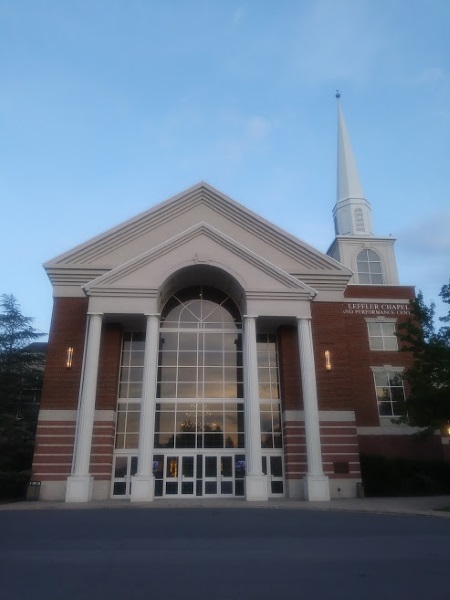
There were around 200 attendees; many seemed to be involved in health care or academia, most having some direct connection to the topic at hand. I would estimate of the roughly 200, around 10-15% were Plain community attendees (Amish, Mennonite, Brethren).
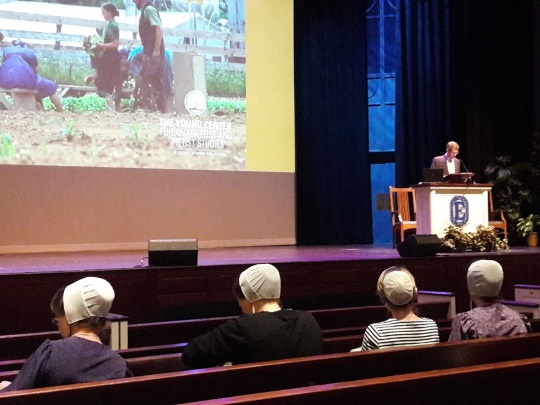
The format was several main speakers, sandwiched between 90 minute blocks where you could attend one of four concurrently running sessions. Those typically had 3 speakers each, who spoke for around 20-25 minutes, with a Q-and-A session at the end.
Obviously you miss a lot by not being able to be in four places at once, but usually for me there was one session that stood out as far as my own interests go, so the choices of which to attend were usually pretty easy.
Below are a few highlights from the sessions I attended. There were many good speakers and interesting topics, even if you are not involved in the health and medical side of things, as was my case.
In the first session I attended, safety educator Kay Moyer told the story of children’s reflective safety vests in Lancaster County. Kay is well-known throughout Lancaster County’s Plain population. She often visits Amish schools to promote wearing the vests.
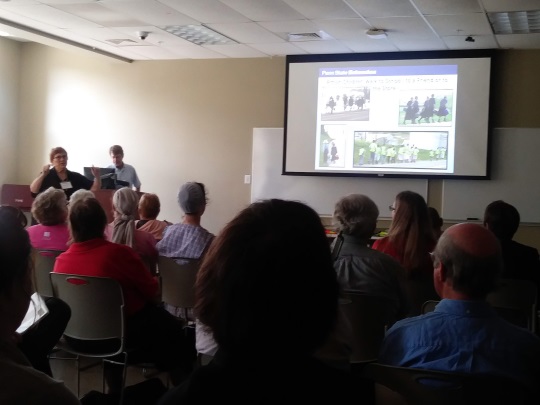
The children of the Amish family I was staying with knew her from her visits to their school. One even had a dramatic story of the safety vest preventing a potentially tragic accident.
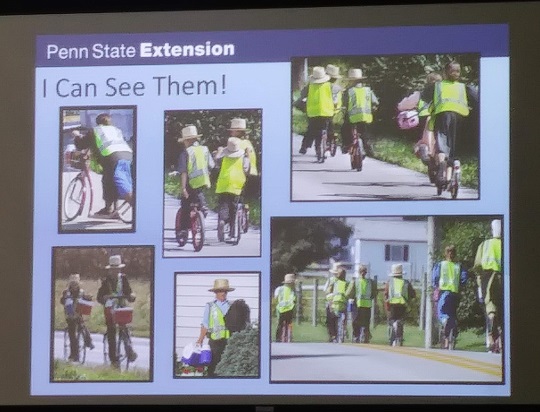
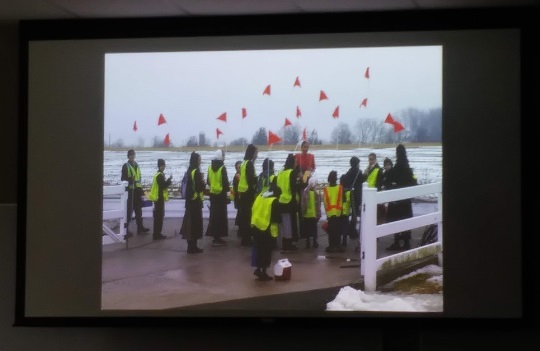
Kay described how they were able to set up a program where members of the community made the vests so that they could be provided at a discounted price, compared to commercially-produced vests (and a better fit, to boot). She passed around one example for the audience to inspect:

This next slide shows the differences between safety materials. It’s not too visible in my photo, but the slide tells you that the common Amish clothing colors black and blue are not easily-discerned on the road – only at about 50-some feet away. Red is visible at around 80 feet, yellow at 120, and white does the best of the colors here, at 180-foot visibility.
However, reflective material is leaps and bounds ahead of them all – visible to drivers at 500 feet. Thus the importance of getting Amish children to wear their vests (which they don’t always like doing, Kay explained).
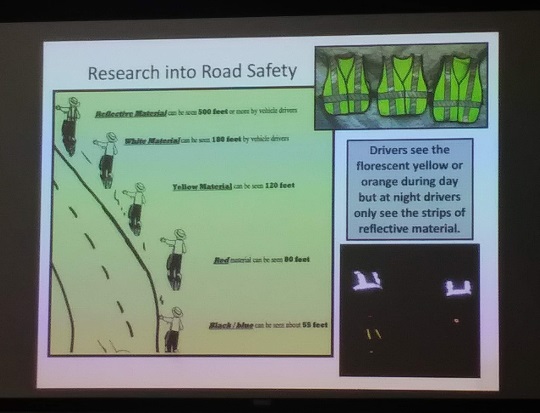
In a later session, Pennsylvania Dutch: The Story of an American Language author Mark Louden discussed linguistic mediation between Amish and health care professionals. It can be very helpful to have a person on staff who is a native Pennsylvania Dutch speaker (one example is Crist Beiler, an Amish-raised RN who serves as a medical interpreter for the Plain community). Mark kindly shared some of his slides with us; here is an excerpt he shared from an article on Crist Beiler:
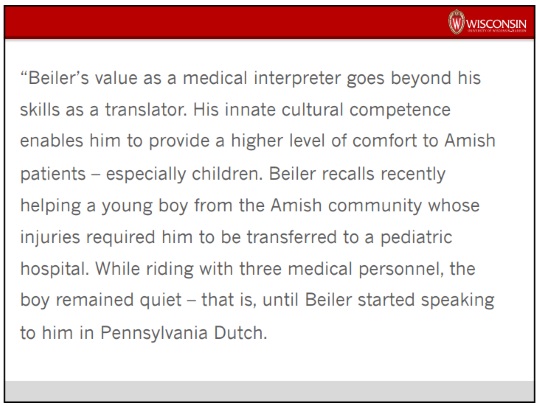
As one Amish patient said, Es schpiert yuscht gut fer epper do hawwe as ich Deitsch schwetze kann demit (“It just feels good to have someone here that I can talk Dutch with”).
I learned some interesting Pennsylvania Dutch medical terms from Mark’s session, including Emergency-Schtubb (emergency room) and Dokter-Schtofft (medicine). An English version of this latter term was used in earlier times (“doctor stuff)” and became a “loan translation” adopted into Pennsylvania Dutch speech.
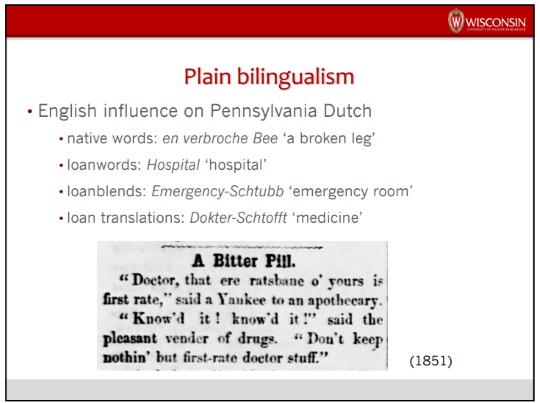
Pennsylvania Dutch is not often used in written form (for example, Amish write to each other using English, not Pennsylvania Dutch), but there have been various attempts to use the language in written text. Here is an amusing example of multi-language patient materials used by BlueCross BlueShield of Montana:
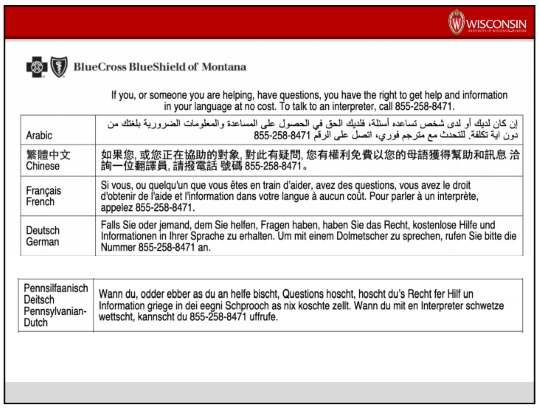
Mark also had an interesting earlier talk on wound care (using burdock leaves and the popular-among-Amish B&W Salve).
Here, Alan Shuldiner discusses developments at the University of Maryland Amish Research Clinic.
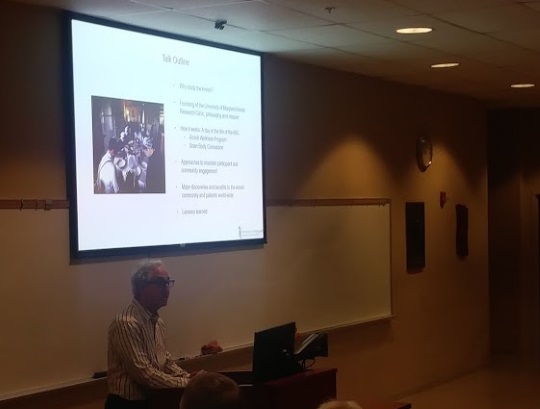
His co-speakers shared more from the Clinic for Special Children in Lancaster County. It seems there are a growing number of clinics and professional institutions addressing medical issues in the Plain population.
Donald Kraybill discussed the negotiating with modernity framework used in his long career of Amish research. Saloma Furlong, author of Why I Left The Amish, also shared on her Amish story and background in this session.
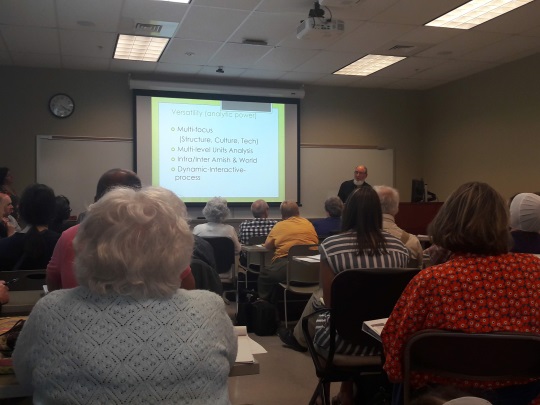
Chuck Yantzi gave a history of the Amish and Plain-run mental health facilities. Many have sprung up around the country over the past two decades. This may have been the most interesting presentation of them all for me. In part that’s because it was an unexpectedly interesting topic, and in part because of Chuck’s engaging delivery.
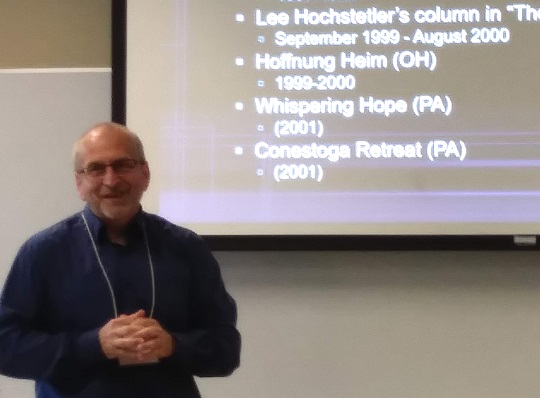
These facilities are run with varying degrees of outside involvement, and varying combinations of traditional clinical care and a more “Plain-friendly”, spiritually-based approach to bring their patients back to health.
There are some facilities that are for couples, but typically they are men-only or women-only facilities (with some focused on youth and teens of each gender). Practical work figures into the equation in many cases. Facilities will have on-site workshops for residents to build furniture and do other productive tasks.
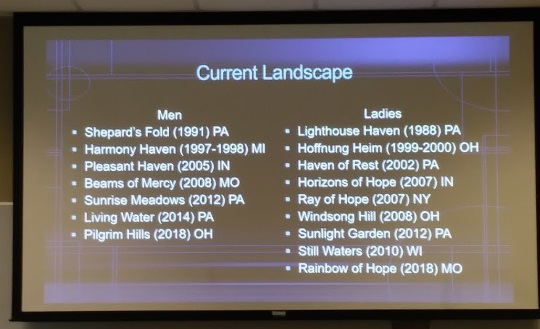
The main speakers were good. Those talks all took place in the main auditorium of Leffler Hall. Here is Young Center director Jeff Bach introducing one of the speakers:
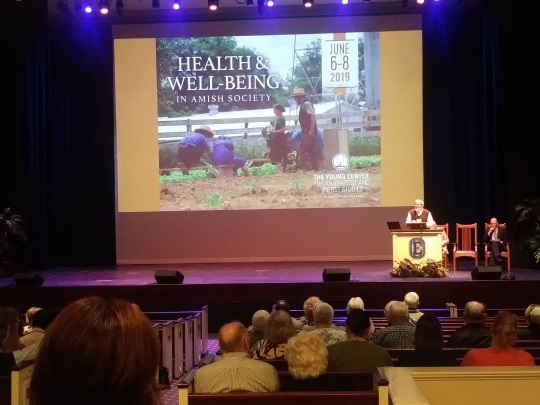
Here is Steven Nolt with Joseph B. Martin, who gave the keynote address.
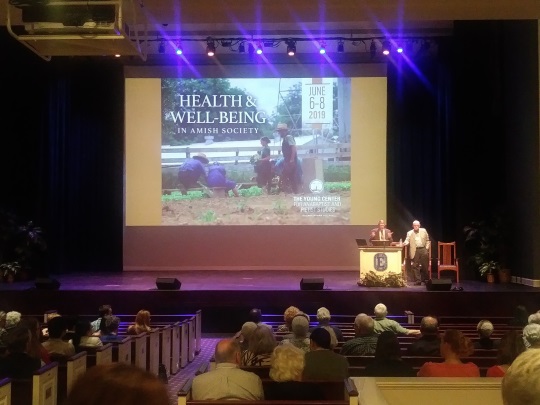
Joseph Martin discussed how giving a drug normally used for treatment of a condition before symptoms appear, could actually prevent that condition’s onset by many years. The trick is identifying who should receive the drug. He also gave case studies concerning two diseases which afflict the Amish, cystic fibrosis and spinal muscular atrophy.
Regarding the second, I recalled seeing a national story just weeks earlier about a new drug which had been called the most expensive ever, at $2.1 million for treatment. It turns out that this was a spinal muscular atrophy treatment, which Dr. Martin discussed in his talk. Apparently it is a very promising drug. I would expect it to be so, at that cost.
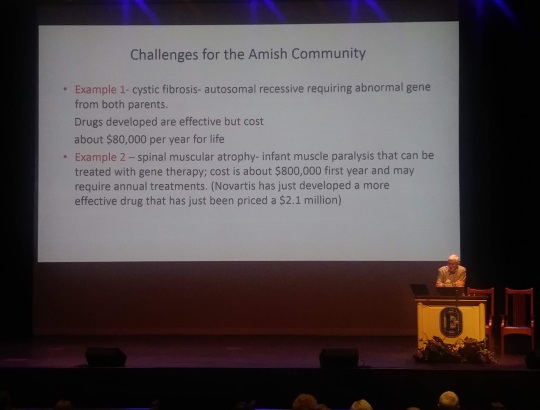
Martha King discussed the various combinations of health care which Amish avail themselves of, which she termed “Amish medical pluralism.” Different Amish families, communities and individuals make use of varying packages of five medical pathways – Home Care, Chiropractic, Medical Tourism, Midwifery, and Biomedicine (conventional medicine).
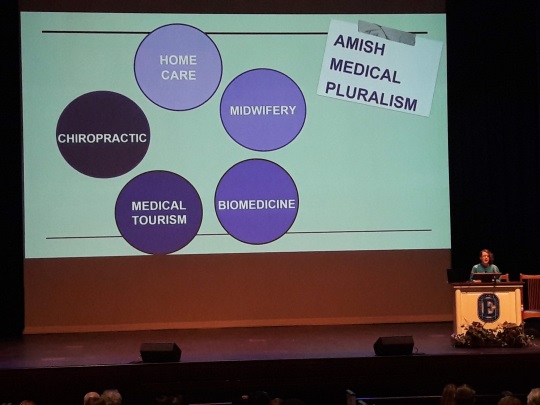
Melissa Thomas spoke about thoughtful engagement with Plain communities – addressing not only “what” and “how”, but also the “why” – as in why certain groups exhibit health disparities. The Project Hoffnung initiative has helped bring tools to Plain communities to more effectively address the issue of breast cancer.
Melissa also introduced an interesting book project called Life Through Their Lens, which contains photos of Amish and Mennonite communities, curated by members of those communities. I picked up a copy before I left; more to come on that.
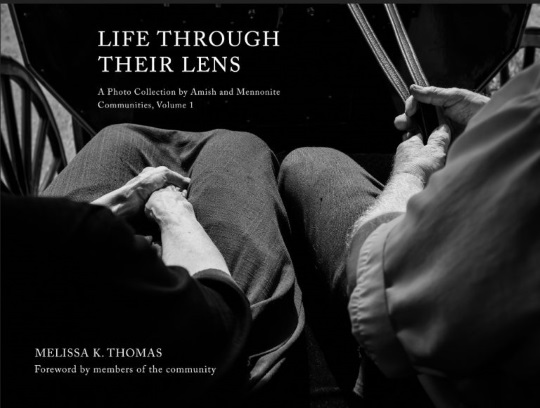
Katherine Hempstead’s plenary address was very interesting in that she discussed the ways that health care costs and negotiations were not transparent. Almost no one pays the “official price” at a medical institution, but the negotiating process between hospitals and insurance companies remains shrouded in secrecy.
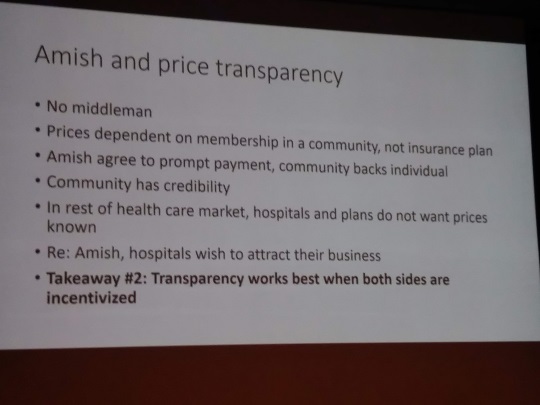
Furthermore, the way these institutions list their services and prices for those services is very confusing. In contrast, an example institution dealing directly with Amish, who typically negotiate cash payments on collective terms, presents very clear and easy-to-understand pricing.
You can see what I’m talking about in this slide. Which medical procedure language and descriptions are easier to understand – the top set, from a booklet for the Plain Community, or the bottom set, from a traditional hospital’s pricing documentation?
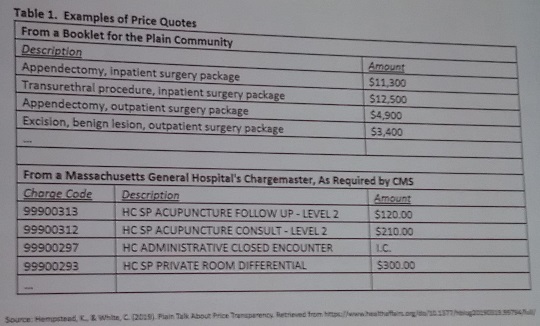
In addition to the speakers presenting their research, there were some posters in a side room of Leffler Chapel detailing other Amish-related research studies.
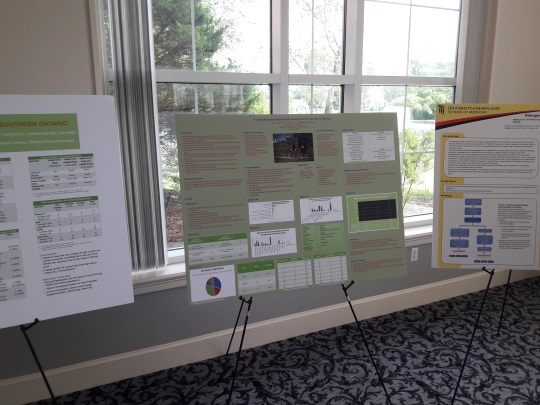
This one was about Amish migration to three new Canadian provinces (New Brunswick, Prince Edward Island, and Manitoba), so you know that caught my eye:
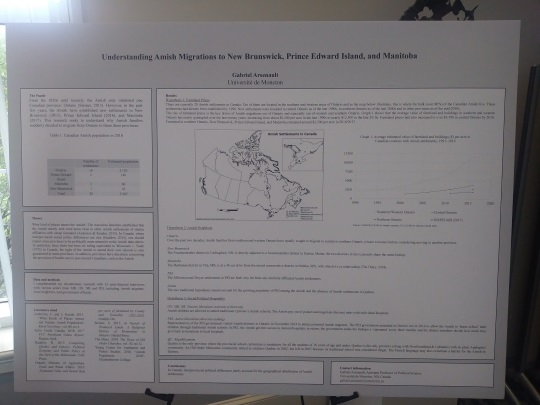
The conference bookstore was open for anyone wanting to pick up an Amish or Plain-themed book:
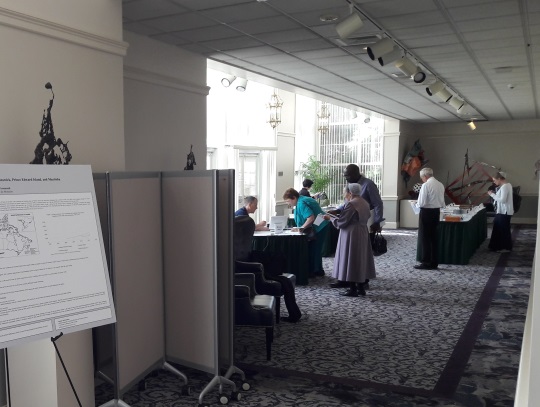

I enjoyed connecting with some friends I hadn’t seen in a long time at this conference. I already mentioned Mark Curtis (by the way, we have a winner of the mystery supper contest, see here); there were some other familiar faces from both Pennsylvania and the Midwest in attendance. I met a couple of Amish attendees I did not already know, one of whom made the trip over from a county west of Lancaster (Franklin I believe).
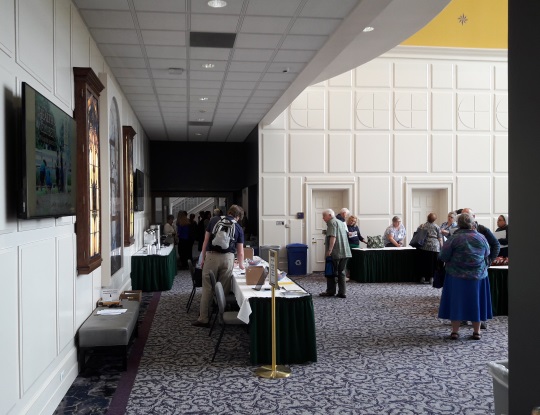
I was also happy for the time to catch up with Lancaster County friends. I was staying with a couple of Amish friends and would travel each day the 30 minute trip from the main Amish area of the county to the college and then back.
My brother was along for this trip as well, which helped on the drive and the company. We stayed a few days after the conference ended, visiting and spending time with Amish families we know.
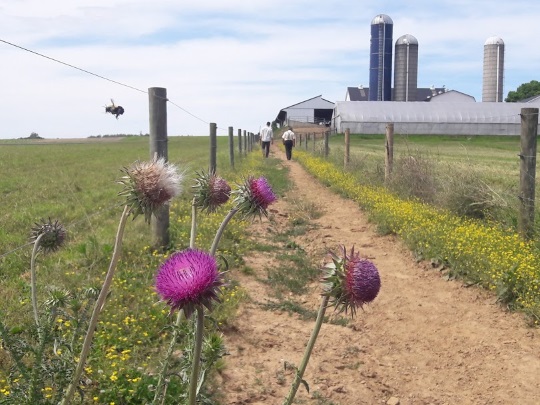
All in all, it was an enriching three days and I was very glad I attended. The next Amish conference at Elizabethtown College is slated for 2022.


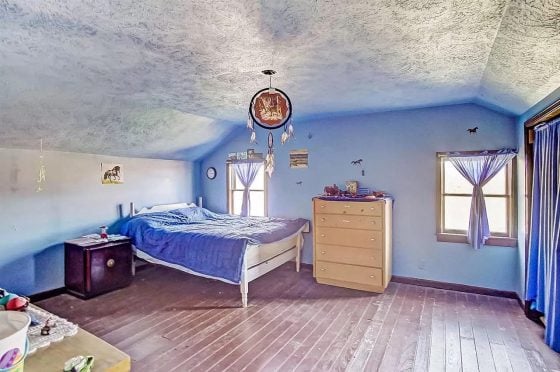

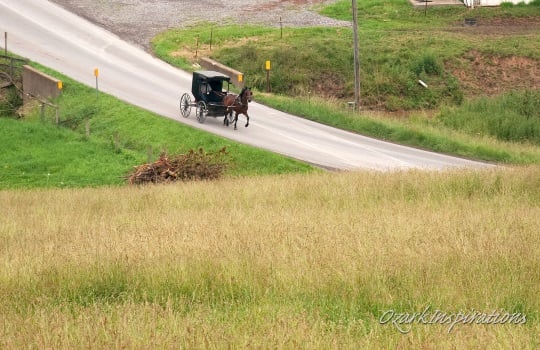
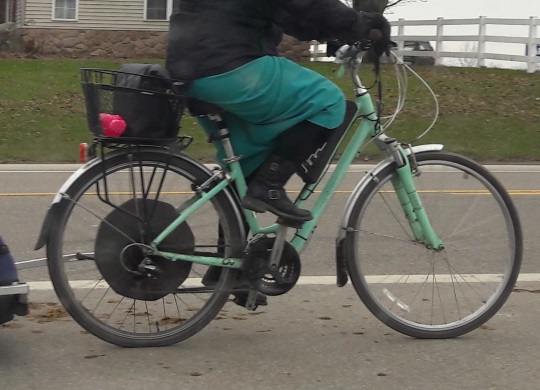
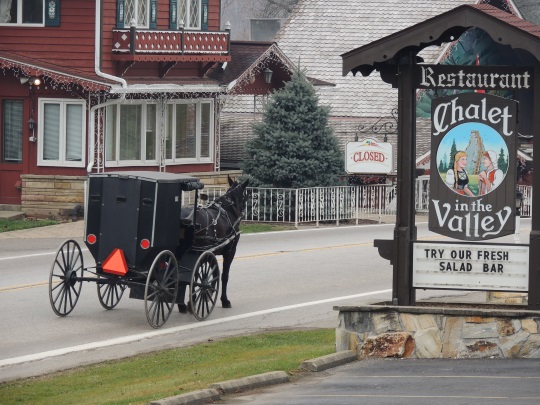
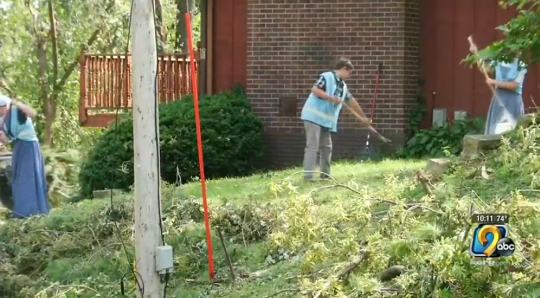
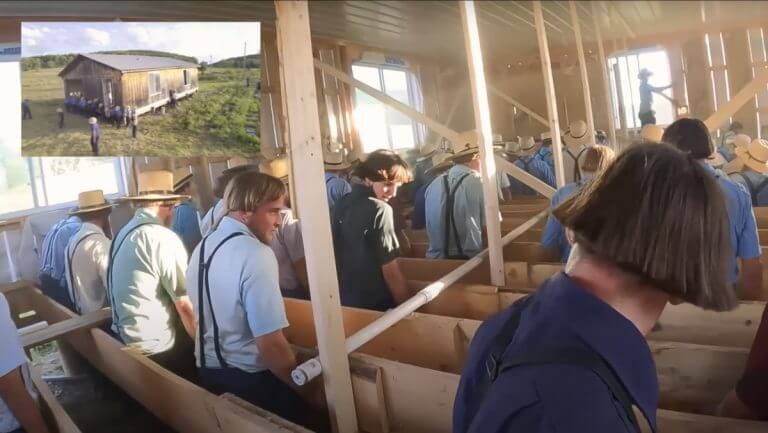
I am originally from Lancaster Co and I am also a nurse practitioner (ret)
I am only culturally ‘plain’, but have a high interest in matters of health.
The son of an Amish raised family died without a proper diagnosis even after being assessed at John Hopkins. There was speculation of some disease found primarily in Amish populations, but never proven.
Your article is excellent and the idea of the conference exemplary; it would be encouraging to have more Amish,’plain’persons in attendance and/or presenters. Thanks for your site.
I’m glad you found it interesting Phyllis and thanks for your service in nursing. I got the feel from this conference that advances are constantly being made, so hopefully fewer and fewer will suffer the fate of the family’s son you mentioned.
Enjoyed the informative article along with the photos.
Could you provide the titles of the books in the photo on the long table ?
With appreciation, Anna
Amish books on the table
Sure thing Anna, there are some good books there. Of the ones I can make out in the photo:
Nature & the Environment in Amish Life (McConnell & Loveless)
Serving the Amish: A Cultural Guide for Professionals (Cates)
The Amish: A Concise Introduction (Nolt)
An Amish Paradox (Hurst & McConnell)
The Amish (Kraybill, Johnson-Weiner, Nolt)
Amish Grace (Kraybill, Nolt, Weaver-Zercher)
The Amish Way (Kraybill, Nolt, Weaver-Zercher)
Amish Society (Hostetler)
The Riddle of Amish Culture (Kraybill)
Growing Up Amish: The Rumspringa Years (Stevick)
New York Amish: Life in the Plain Communities of the Empire State (Johnson-Weiner)
Success Made Simple: An Inside Look at Why Amish Businesses Thrive (Wesner)
Your Comments on the 2019 Amish Conference on Health and Well-Being
I thoroughly enjoyed reading your comments and seeing the photos of your attendance at the 2019 Amish Conference on Health and Well-Being. Thanks for the excellent article.
I’m curious to understand the term “Medical Tourism” as one of the five medical pathways that the Amish use. Can you explain the term “Medical Tourism” and what it entails? Thanks
Medical Tourism and the Amish
Good question Suzanne, and I’m glad you liked the article, thank you.
Medical Tourism in the case of the Amish generally refers to traveling out of the country, usually to Latin American destinations (often Mexico but can be others), for treatments that are not always available in the US, because they have not been approved, or for cheaper health care. There are facilities who advertise to Amish and other groups in Plain publications.
I discuss this point in a bit more detail in the first point in this post:
https://amishamerica.com/5-unconventional-amish-health-practices/
There is also a WSJ article which I link in that post, which also goes into the topic: https://www.wsj.com/articles/SB114048909124578710
I hope that explains it better. I thought about discussing those five points from Martha King’s talk in greater detail in the post, but left it out for length considerations, so I’m glad you asked.
“Life Through Their Lens” Photo Book
You can order the book here.
http://appalcare.org/shop/
Amazing
This commmunity always impress me